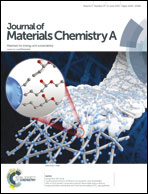Stabilized titanium nitride nanowire supported silicon core–shell nanorods as high capacity lithium-ion anodes†
Abstract
In this work, TiN NW supported silicon nanorods (TiN@Si NRs) are produced via direct radio frequency (RF) magnetron sputtering of Si deposition onto the surface of TiN NWs. Due to its superior mechanical stability and electrical conductivity, TiN provides more stable support and better conductive pathways for Si when compared with TiO2. The unique core–shell TiN@Si NR structure has enough void space to accommodate the large volume changes of Si during charge/discharge cycling. The novel 3D architecture electrode demonstrates exceptional electrochemical performances with ultrahigh specific capacity. Comparing with TiO2@Si NRs, TiN@Si NR electrodes exhibit improved cycling performances, which can still retain a capacity of 3258.8 mA h g−1 after 200 cycles at 1 A g−1. It should be noted that the TiN@Si NRs show an excellent rate performance even at a high current density (2256.6 mA h g−1 is realized at 10 A g−1). These results endow the electrodes with high power and long cycling stability.


 Please wait while we load your content...
Please wait while we load your content...